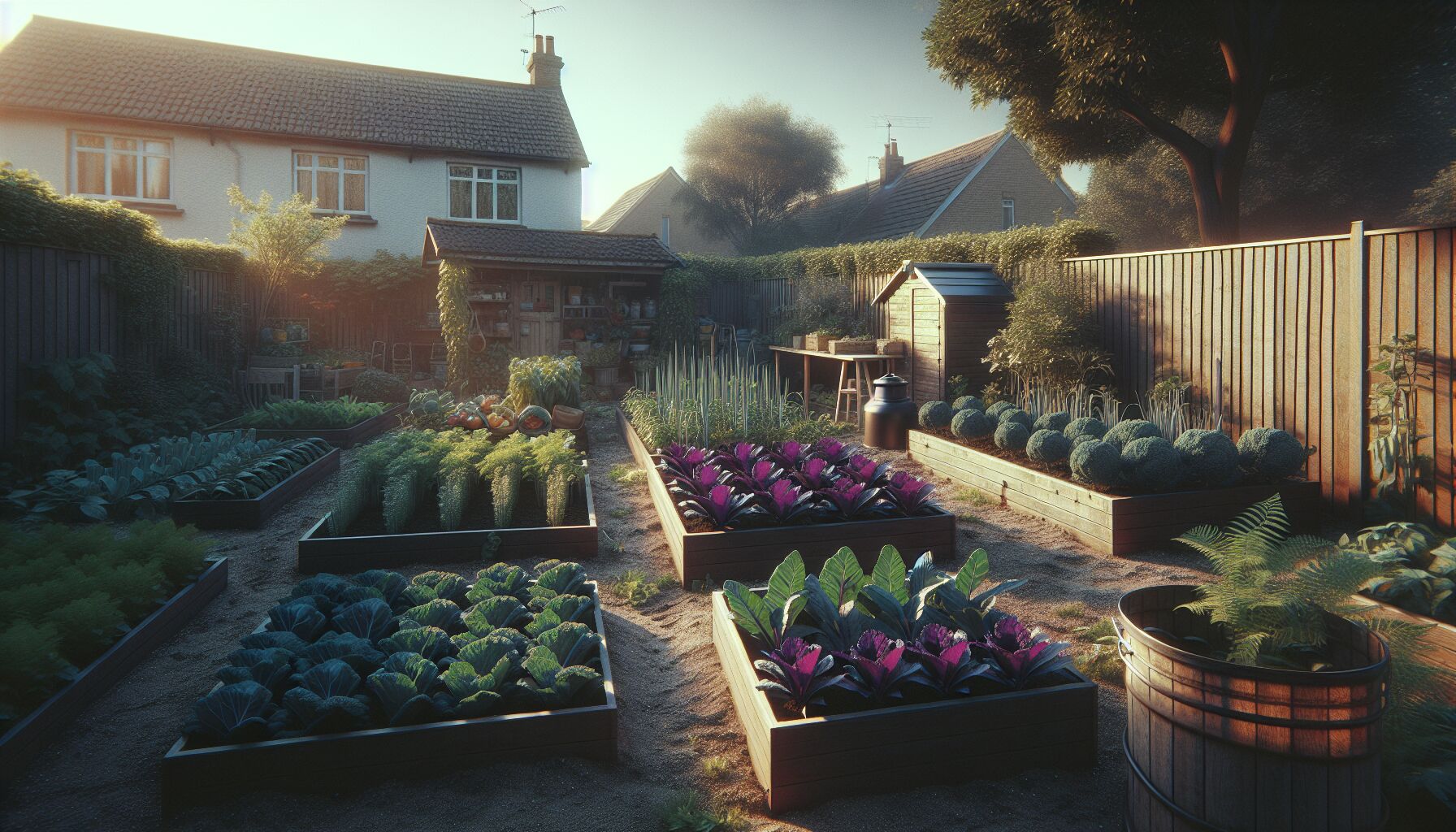 Let’s be real—most suburban yards are underachievers. Green lawns trimmed to perfection but doing little more than hoarding water and drawing the occasional squirrel. That same patch of land, with a little creative thinking and old-fashioned elbow grease, could become a hotbed for suburban sustainability—and not just metaphorically.
Let’s be real—most suburban yards are underachievers. Green lawns trimmed to perfection but doing little more than hoarding water and drawing the occasional squirrel. That same patch of land, with a little creative thinking and old-fashioned elbow grease, could become a hotbed for suburban sustainability—and not just metaphorically.
Think about it. Even a quarter-acre lot can punch above its weight. Raised garden beds can line the perimeter where ornamentals once paraded. Tomatoes, kale, maybe a few quirky additions like purple carrots or Thai basil—not just for show, but for real meals, real nourishment. A compost bin in the corner? Not glamorous, but it keeps your food waste working overtime, turning banana peels into black gold. No need for an acreage to start living with a touch more self-reliance.
“To forget how to dig the earth and to tend the soil is to forget ourselves.” — Mahatma Gandhi
If that feels a bit heavy, it’s meant to. Growing even a fraction of your food reshapes how you think about convenience, quality, and independence. And no, you don’t need a tractor—just good gloves, a bit of planning, and maybe a few weekends shifting mulch.
Now, if you’re feeling ambitious (and a little rebellious), a chicken coop fits surprisingly well in many suburban corners. We’re talking six to eight hens, plenty for a couple of egg-loving households. They’re low-maintenance, goofy in the best way, and offer a tangible rhythm to your mornings. You’ll start to differentiate clucks the way coffee lovers pick out roast profiles.
Of course, backyard livestock isn’t all sunshine and yolks. There are local ordinances, HOA whispers, and the possibility of one rogue hen turning into suburban legend. But balance is the name of the game here. Sheep or goats may sound appealing in theory, but unless you’re zoning-flexible or live on the more rural fringe, you’ll want to rein it in.
Still, space isn’t just about animals or plants. It’s not even always about productivity on paper. Part of wise land use is avoiding waste—simplifying. A rain garden catches runoff beneath a downspout while doubling as a pollinator haven. A cluster of fruit trees provides shade and snacks, plus you get the added bonus of something incredibly grounding: watching dormant branches erupt into bloom each year.
Sheds can do better, too. Instead of dumping grounds for rusting rakes and mystery boxes, think mini-workshop powered by solar panels, or just a quiet room to recharge—literally or metaphorically. These dual-purpose spaces help nudge you closer to an off-grid hybrid lifestyle without sacrificing weekend brunch plans or Netflix on a Friday night.
And let’s not ignore layout. Paths made of reclaimed brick or stone, herb spirals near the door, vertical trellises for cucumbers climbing skyward—space-wise doesn’t mean space-starved. It just means thinking long-term. Every square foot should earn its keep, whether by feeding, sheltering, harvesting rain, or simply healing your nerves after a wired-up week.
Need a mental short list? Here’s what intentional suburban land use tends to involve:
- Raised garden beds: Easy to manage, productive, and aesthetically clean.
- Perennial crops: Think asparagus, berry bushes, and rhubarb. They deliver yearly with minimal fuss.
- Multiple-use zones: A sitting area that doubles as a pollinator patch or picnic zone with edible landscaping.
- Micro-scale livestock: Chickens are popular, but quail or rabbits also thrive in small spaces.
- Composting: Traditional bins, worm towers, or bokashi systems all close the loop on kitchen waste.
Each of these components builds layers of function, style, and independence. More subtly, they shift our relationship with what it means to live “between” city and country. And sure, some trial and error is bound to show up—squash vine borers, anyone? But you’ll become fluent in your yard’s microclimate, your soil’s quirks, and your own thresholds for chaos vs. control.
Also, let’s talk kids—if you’ve got them, there’s arguably no better backyard education than watching peas sprout or collecting eggs with half-asleep hair. Forget Pinterest-perfect playhouses; this is hands-on science with dirt under the fingernails.
So while others spend weekends sanding fences or re-mulching flower beds purely for curb appeal, you’ll be making decisions with impact—on health, wallet, and yes, even the climate. And that’s where suburban sustainability gets its real momentum—from those willing to flip the old suburbia script and demand more from the land beneath their feet.
Not because it’s trendy, but because it just makes sense.
Smart home infrastructure: integrating technology for energy and water efficiency
Picture your suburban home humming quietly in the background—appliances ticking along, the HVAC doing its thing, lights gently responding to changing daylight outside. All of it running smarter, cleaner, lighter. That’s not some utopian pipe dream hidden in Silicon Valley brochures. It’s real, it’s doable, and it’s slowly becoming the norm for folks chasing resilience and suburban sustainability without giving up comfort.
You’re not alone if the words “smart home infrastructure” still conjure images of refrigerator touchscreens that read you the news. Sure, those exist (and can be quirky fun), but this kind of smart goes deeper. It’s about efficiency—making energy and water systems work intelligently so you don’t have to micromanage your entire house like a full-time operator. It’s about self-reliance with a subtle tech backbone.
Start with energy. Solar panels are no longer the novelty they were a decade ago, and frankly, that’s a good thing. Prices have nosedived, battery tech has leveled up, and integration tools like the Tesla Powerwall or Enphase systems are bringing whole-home thinking to what used to be just about wattage. A few sunny days can stockpile enough juice to keep your fridge lit during grid hiccups—and depending on your setup, contribute back to the grid too.
“As we look ahead into the next century, leaders will be those who empower others.” — Bill Gates
Empowering, in this context, means not waiting for utility companies to fix aging infrastructure or weatherproof the grid. You can build an off-grid hybrid system right where you are—pair solar with insulation upgrades and smart thermostats, and suddenly, you’re reducing dependency without sacrificing Wi-Fi speeds or espresso machines.
Okay, but here’s where things get sneaky-technical: your house might be wasting more energy than you think. Old ductwork loses heat like a leaky balloon. Phantom loads—power used by idle electronics—can add up fast. Enter smart plugs, energy monitors like the Sense Energy Monitor, and usage apps that literally show you what’s working too hard. You may discover your “eco mode” dishwasher is a bit of a diva.
Now swing over to water. It’s impossible to talk about home infrastructure without addressing the gallons slipping through the cracks. From automatic moisture sensors hooked to drip irrigation, to dual-flush toilets and graywater reuse systems, the solution isn’t just about saving money (though you might track that on your next water bill). It’s about slowing down the flow between nature and utility. Rain barrels? Classic. But combo systems that auto-feed raised beds while syncing with your weather app? That’s next-level.
And yet, the charm of all this tech lies not just in its function—but in how invisible it becomes when it’s working right. A home powered with intelligence runs quietly in the background, often unnoticed unless you choose to geek out on dashboards and consumption reports (no shame if you do—some of us are green data nerds).
Still, all of this works best with a shift in mindset. You’re no longer just paying for energy or water. You’re stewarding a system. Imagine suburban life where homes passively adjust light levels with the sun’s arc; where your garden tells your phone when it’s thirsty; where excess solar from your roof powers your neighbor’s garage EV charger. That’s not fantasy. That’s cooperative resilience in a cul-de-sac.
Naturally, there’s a balance here. Some gadgets promise more than they deliver. That Wi-Fi-connected pressure cooker probably isn’t moving the sustainability needle. But when panels, sensors, and dual-tank systems all quietly interlink? That’s suburban self-reliance made real.
And yes, retrofitting isn’t always cheap upfront. But think about your monthly spend: cable packages, streaming services, takeout—many of those costs add up without improving your home’s baseline efficiency. Frame your next smart upgrade as an investment in both future function and daily friction reduction. That’s money well cycled.
A few standout upgrades folks are leaning into right now:
- Smart thermostats: Ecobee and Nest adapt to your routine, trimming costs while keeping you cozy.
- Rainwater harvesting systems: Not just barrels, but gravity-fed setups for pressure and reach.
- Whole-home battery backups: Keeping fridges running and chargers live when the grid wobbles.
- Solar + heat pump pairings: Efficient heating/cooling that syncs beautifully with renewable power.
- Leak detection systems: Tools like Flo by Moen or Phyn prevent home-status drama before it begins.
Let me explain why this matters beyond the hardware. As weather patterns get stranger and grids less predictable, suburbs risk getting hit twice—by unreliable infrastructure and by energy politics they can’t control. So designing with foresight doesn’t just feel prudent—it becomes a low-key act of rebellion. One that says, “We’ll be okay. We’re paying attention.”
Pulling together your own self-sufficient setup might happen in stages. Maybe this spring it’s smart meters and rain sensors. Next year? A leap into solar-powered sheds or learning which zone valves match your irrigation needs. It’s okay to move incrementally. What
Community and commerce: building local networks and sustainable economies
 Call it connecting the dots or just getting neighborly again, but if we’re serious about suburban sustainability, it can’t stop at the property line. It’s not enough to grow your own food or install solar panels; long-term self-reliance thrives best when it’s shared. In practical terms, a radish in your garden becomes exponentially more valuable when bartered for your neighbor’s fresh eggs or a mechanic’s know-how. That’s not just nostalgic fantasy—that’s micro-economics at work.
Call it connecting the dots or just getting neighborly again, but if we’re serious about suburban sustainability, it can’t stop at the property line. It’s not enough to grow your own food or install solar panels; long-term self-reliance thrives best when it’s shared. In practical terms, a radish in your garden becomes exponentially more valuable when bartered for your neighbor’s fresh eggs or a mechanic’s know-how. That’s not just nostalgic fantasy—that’s micro-economics at work.
Let me explain: when suburban communities start building intentional networks—whether through local co-ops, pop-up skill swaps, or tool libraries—it reduces collective dependence on fragile supply chains. Suddenly, a lost Amazon package or a weeklong power outage doesn’t derail your household. It just means leaning a little harder on the folks across the street. Sound old-school? Maybe. But timeless systems tend to outlast trends.
Take the humble CSA (Community Supported Agriculture). This model’s morphed in suburbia, where backyard growers now collaborate with neighbors to establish hyper-local produce exchanges. One household handles cucumbers and squash, another goes heavy on leafy greens and peppers. Toss in a few suburban beekeepers, and suddenly you’ve got a thriving ecosystem in cul-de-sacs once dominated by riding mowers and HOA bylaws.
Seasonal markets, even front-yard produce stands, aren’t out of reach either. In many suburban pockets, small batches of homemade pickles, herb-infused oils, or local Kombucha trades are sprouting up like wildflowers. Pair this with digital tools—Telegram threads, Facebook neighborhood groups, or the Buy Nothing Project—and what used to be silent suburbs start humming with practical exchange and subtle resilience.
“Never doubt that a small group of thoughtful, committed citizens can change the world.” — Margaret Mead
Local change doesn’t have to mean grand gestures. It might look like a group of families investing in a shared dehydrator to preserve summer harvests. Or co-purchasing a small cider press because three yards’ worth of apples beg for a bigger stage. Kids helping each other build pollinator hotels. Retirees teaching teens how to sharpen tools or plant by the moon. None of it flashy, yet all of it foundational.
Even commerce gets a different spin under this model. As big-box stores choke on supply delays and everything’s backordered until further notice, cottage industries in suburbia are experiencing a quiet boom. Think: lawn mower repair out of a garage, soap-making in spare rooms, tutoring on porches. These aren’t just hobbies—they’re anchors in a local economy that doesn’t rely as heavily on fossil fuel-laden logistics or outsider corporations.
There’s real emotional power in this, too. When you buy eggs from your neighbor’s back-porch fridge, you’re not just paying for protein—you’re building trust. And when your Saturday ritual includes walking past three small stand setups selling cookies, succulents, and sourdough starters, the street feels alive in a way strip malls can’t replicate. Honestly, who doesn’t want to know the face behind the basil?
Still, the glue in all of this lies in shared systems—things that wouldn’t make sense individually, but shine when coordinated:
- Tool libraries: Rent a post-hole digger or share a hedge trimmer. Why should every house buy a mini lumberyard?
- Community compost hubs: Convert shared food scraps into compost gold, especially in HOA-heavy zones where bins aren’t allowed.
- Seed-swaps & plant exchanges: A spring afternoon turns into free planting materials and new friendships.
- Bulk co-ops: Order 50-pound bags of oats, flour, or rice at wholesale and divvy it up across households.
In some neighborhoods, residents have even pooled funds to install communal solar arrays—essentially mini grid-share systems between clustered homes. That’s about as off-grid hybrid as a suburb gets, while still maintaining full access to modern convenience. It’s the kind of forward-thinking design that nudges us closer to shared independence—aligning privilege with purpose.
Of course, building these networks takes effort. Not everyone’s ready to trade the anonymity of cul-de-sac living for the commitment of community meetings and shared responsibilities. That’s fair. But for those who do lean in, the payoff isn’t just in resilience—it’s in connection. Suburban life, long caricatured as isolated and transactional, starts feeling more like a village again.
And yes, it gets messy. Someone forgets to return the shared ladder. Someone sells cupcakes with slightly questionable frosting. But the bigger picture remains: each misstep teaches, each small success builds capacity. In time, you see the shift—fewer solo errands, more driveway chats, fewer disposable purchases, more services traded in labor or skills.
Suburban self-sufficiency doesn’t have to forsake convenience or comfort. It just asks that we reframe them. What if convenience means calling Bill across the street instead of relying on an algorithm? What if comfort includes knowing you can grow, build, or trade for what you need—even if trucks stop showing up?
 DS Haven In Light Of Things
DS Haven In Light Of Things






